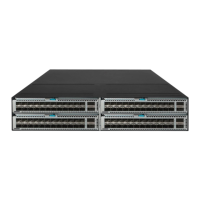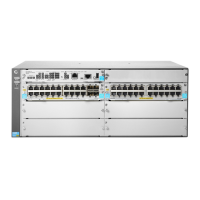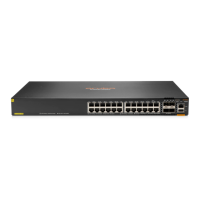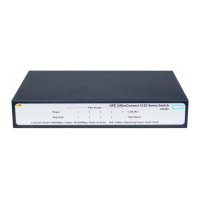269
Disabling LLDP PVID inconsistency check
By default, when the system receives an LLDP packet, it compares the PVID value contained in
packet with the PVID configured on the receiving interface. If the two PVIDs do not match, a log
message will be printed to notify the user.
You can disable PVID inconsistency check if different PVIDs are required on a link.
To disable LLDP PVID inconsistency check:
Step Command Remarks
1. Enter system view.
system-view
N/A
2. Disable LLDP PVID
inconsistency check.
lldp ignore-pvid-inconsistency
By default, LLDP PVID
inconsistency check is
enabled.
Configuring CDP compatibility
To enable your device to exchange information with a directly connected Cisco device that supports
only CDP, you must enable CDP compatibility.
CDP compatibility enables your device to receive and recognize CDP packets from the neighboring
CDP device and send CDP packets to the neighboring device. The CDP packets sent to the
neighboring CDP device carry the following information:
• Device ID.
• ID of the port connecting to the neighboring device.
• Port IP address.
• TTL.
The port IP address is the primary IP address of a VLAN interface in up state. The VLAN ID of the
VLAN interface must be the lowest among the VLANs permitted on the port. If no VLAN interfaces of
the permitted VLANs are assigned an IP address or all VLAN interfaces are down, no port IP address
will be advertised.
You can view the neighboring CDP device information that can be recognized by the device in the
output of the display lldp neighbor-information command. For more information about the display
lldp neighbor-information command, see Layer 2—LAN Switching Command Reference.
To make your device work with Cisco IP phones, you must enable CDP compatibility.
If your LLDP-enabled device cannot recognize CDP packets, it does not respond to the requests of
Cisco IP phones for the voice VLAN ID configured on the device. As a result, a requesting Cisco IP
phone sends voice traffic without any tag to your device. Your device cannot differentiate the voice
traffic from other types of traffic.
CDP compatibility enables your device to receive and recognize CDP packets from a Cisco IP phone
and respond with CDP packets carrying TLVs with the configured voice VLAN. If no voice VLAN is
configured for CDP packets, CDP packets carry the voice VLAN of the port or the voice VLAN
assigned by the RADIUS server. The assigned voice VLAN has a higher priority. According to TLVs
with the voice VLAN configuration, the IP phone automatically configures the voice VLAN. As a result,
the voice traffic is confined in the configured voice VLAN and is differentiated from other types of
traffic.
For more information about voice VLANs, see "Configuring voice VLANs."
When the device is connected to a Cisco IP phone that has a host attached to its data port, the host
must access the network through the Cisco IP phone. If the data port goes down, the IP phone will
send a CDP packet to the device so the device can log out the user.

